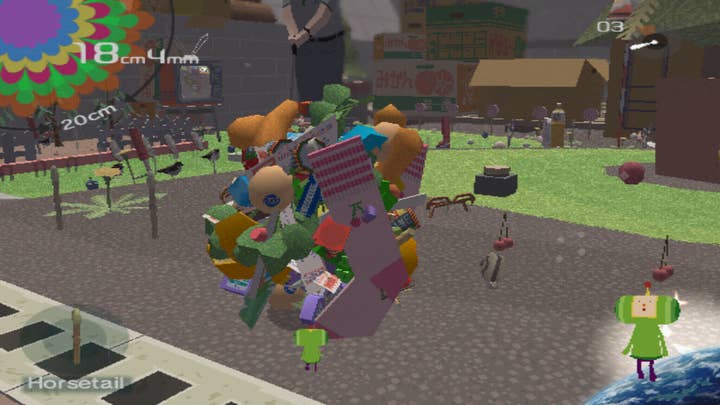Katamari Damacy | Why I Love
Exit Plan Games co-founder Jose Teixeira shares his thoughts on Keita Takahashi's original 2004 cult hit, both as a player and as a developer
Why I Love is a series of guest editorials on GamesIndustry.biz intended to showcase the ways in which game developers appreciate each other's work. This entry was contributed by Sigtrap co-founders Gary Lloyd and Luke Thompson, who launched the Time Crisis-inspired Under Cover on Meta Quest earlier this month.
Katamari Damacy was one of my favorite games long before I ever became a game developer. But now I love it even more.
So picture this: the year is 2004. The PlayStation 2 and Xbox are in the middle of their lifetime cycle. Games and graphics have been improving drastically over the last years, becoming more complex, more realistic, more immersive. Studios are keen on taking advantage of these advancing technologies and showcasing the best they can do with them.
And what a year it was! Doom 3, Fable, Far Cry, GTA: San Andreas, Halo 2, World of Warcraft, The Chronicles of Riddick, and that all-time classic, Half-Life 2, among many, many other memorable and groundbreaking titles.
And then there's this group of developers in Japan working for the famous company Namco with this idea for a really fun game called Katamari Damacy. No, it's not going to be groundbreaking. No, it's not going to take advantage of the latest advances in graphics technology. Apparently, the game designer Keita Takahashi had some difficulties pitching the game to Namco's superiors, and… well, I'm not surprised!
As a game developer, and studio co-founder, I know all too well how these meetings can go, and how profit-oriented these superiors/managers/shareholders can be at times. I can almost imagine in my head what this conversation must have sounded like:
Businessman: "Lots of impressive and ambitious games coming out soon. So what is this game about?"
Developer: "Uhhmm… Well, you are a small character, you control a small ball and you push it and roll it around various environments."
Businessman: "I see… so then what happens?"
Developer: "Well, you roll the ball, it gets bigger, and when you get it to a certain size within the time limit, the level finishes."
Businessman: "Okay… then what?"
Developer: "Then the next level starts and… you roll a bigger ball! And then a bigger one, and bigger one, until you're rolling a ball the size of the whole planet!"
Businessman: "So the game is just rolling increasingly bigger balls?!"
Developer: "Yes."
Businessman: "Does this game have any replayability? "
Developer: "I guess… It depends on how much you like rolling balls!"
Businessman: "And what is the ultimate purpose of all of this? What is the objective of the game?"
Developer: "To… please your father"
Businessman: "And who is your father?"
Developer: "He's the… uhhmm… the King of All Cosmos."

In all seriousness, though… Keita Takahashi's courage to pitch this idea in a time like this – when the game industry was trending towards games with an unprecedented level of complexity and graphical fidelity – is nothing short of absolutely legendary.
And if Katamari Damacy was already one of my favorite games of all time before becoming a game developer, now that I have seen the other side, I don't have enough words to express my amount of admiration, respect and gratitude for the developers who had this crazy idea, and whichever high-ups at Namco gave the project a green light and funding. Thanks to you we had the pleasure of playing one of the funniest, wackiest, most creative video games of all time.
It's just such a refreshing title. An absurd and incredibly funny story that just makes you laugh, and serves as a launch platform to unique gameplay mechanics which are easy to get into, difficult to master, and yet despite the simplicity and risk of repetitiveness, somehow manages to stay fresh throughout the whole game thanks to great level design, and the variety of scenarios, environments and challenges thrown at the player. The graphics are straightforward, and completely support the wacky sense of humor that the rest of the game is built on. It's simple, stupid fun, and absolutely brilliant.
Now that I have seen the other side, I don't have enough words to express my amount of admiration, respect and gratitude for the developers who had this crazy idea
Not to turn this into a shameless plug, but in 2019 I started a games studio called Exit Plan with my friend Damien Monnier, and we both love Katamari Damacy so much that it was actually a major inspiration for our debut title, Bang-on Balls: Chronicles.
Like all businesses, game development has trends. And because ultimately games have to sell, companies tend to "play it safe" and follow those trends, meaning they take less risks, and are less likely to be original or creative with their titles, choosing to invest more on 'proven' franchises/ideas rather than risking making something new and different. Making the problem worse is the fact that games are more expensive than ever to make, and taking a risk nowadays is certainly not the same as taking a risk back in 2004.
Fortunately, not all is lost! There are still game developers out there like Keita Takahashi, with wacky, trend-defying ideas that will become all-time classics, and business people who are open-minded and crazy enough to approve these wild endeavors.
And more importantly, there are young gamers who support these developers, play weird and original games, appreciate the risk and effort that it took to make them, and perhaps one day they themselves will become a part of game development history.
Developers interested in contributing their own Why I Love column are encouraged to reach out to us at news@gamesindustry.biz.








